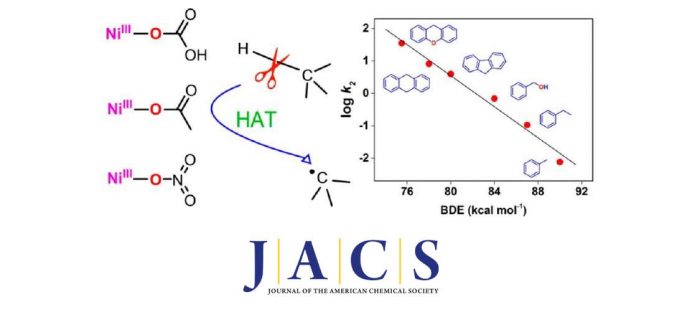Two metastable NiIII complexes, [NiIII(OAc)(L)] and [NiIII(ONO2)(L)] (L = N,N’-(2,6-dimethylphenyl)-2,6-pyridinedicarboxamidate, OAc = acetate), were prepared, adding to the previously prepared [NiIII(OCO2H)(L)], with the purpose of probing the properties of terminal late-transition metal oxidants. These high-valent oxidants were prepared by the one-electron oxidation of their NiII precursors ([NiII(OAc)(L)]? and [NiII(ONO2)(L)]?) with tris(4-bromophenyl)ammoniumyl hexachloroantimonate. Fascinatingly, the reaction between any [NiII(X)(L)]? and NaOCl/acetic acid (AcOH) or cerium ammonium nitrate ((NH4)2[CeIV(NO3)6], CAN), yielded [NiIII(OAc)(L)] and [NiIII(ONO2)(L)], respectively. An array of spectroscopic characterizations (electronic absorption, electron paramagnetic resonance, X-ray absorption spectroscopies), electrochemical methods, and computational predictions (density functional theory) have been used to determine the structural, electronic, and magnetic properties of these highly reactive metastable oxidants. The NiIII-oxidants proved competent in the oxidation of phenols (weak O–H bonds) and a series of hydrocarbon substrates (some with strong C–H bonds). Kinetic investigation of the reactions with di-tert-butylphenols showed a 15-fold enhanced reaction rate for [NiIII(ONO2)(L)] compared to [NiIII(OCO2H)(L)] and [NiIII(OAc)(L)], demonstrating the effect of electron-deficiency of the O-ligand on oxidizing power. The oxidation of a series of hydrocarbons by [NiIII(OAc)(L)] was further examined. A linear correlation between the rate constant and the bond dissociation energy of the C–H bonds in the substrates was indicative of a hydrogen atom transfer mechanism. The reaction rate with dihydroanthracene (k2 = 8.1 M–1 s–1) compared favorably with the most reactive high-valent metal-oxidants, and showcases the exceptional reactivity of late transition metal–oxygen adducts.
The results were published today in Journal of the American Chemical Society:
P. Pirovano, E.R. Farquhar, M. Swart, and A.R. McDonald
“Tuning the Reactivity of Terminal Nickel(III)–Oxygen Adducts for C–H Bond Activation”
J. Am. Chem. Soc. 2016, 138, 14362-14370
[abstract]
DOI: 10.1021/jacs.6b08406

